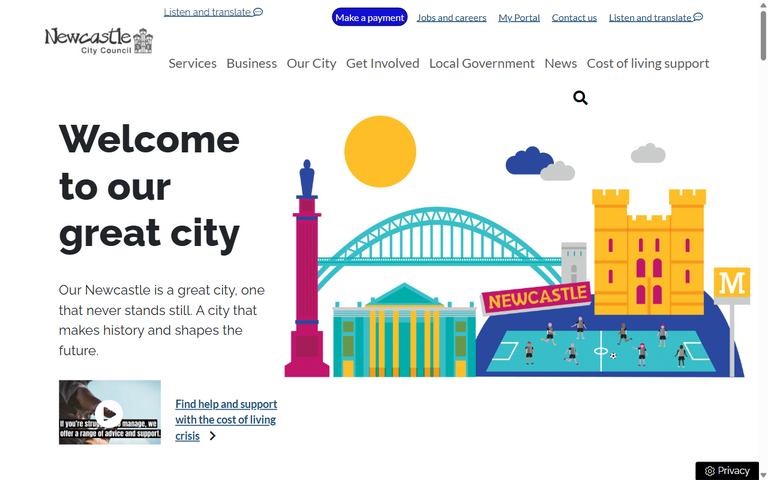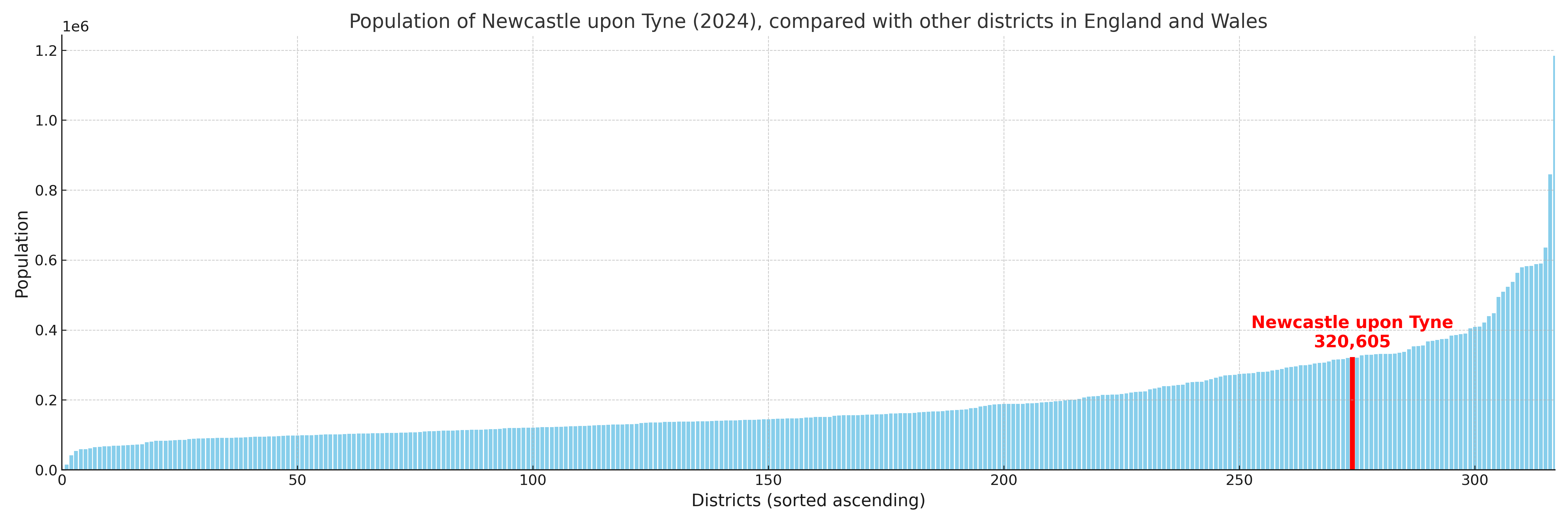Newcastle upon Tyne
§ This page gives an overview of the Newcastle upon Tyne local authority district, bringing together key facts, maps, and data to help you quickly understand the area. One of 361 district profiles on Baseview.
Overview ⁞ Newcastle upon Tyne, set on the north bank of the River Tyne, is a vibrant city with a rich industrial past and a striking architectural heritage. Its iconic skyline includes the medieval Newcastle Castle, Grey Street’s Georgian architecture, and the modern Sage and Millennium Bridge linking it to Gateshead. The River Tyne flows through the heart of the city, where the Quayside has been revitalised into a hub of restaurants, galleries, and nightlife. Newcastle is also home to cultural institutions like the Theatre Royal, Discovery Museum, and the Great North Museum, alongside green areas such as Town Moor and Jesmond Dene. Its riverside location, historic roots, and cultural vibrancy make it one of the North East’s most prominent urban centres.
Newcastle upon Tyne Boundary Map
This map shows the official boundary of the Newcastle upon Tyne local authority district, based on the latest geographic data published by the Office for National Statistics (ONS). It provides a clear view of the district’s extent and helps you understand how the area fits within the wider regional and national landscape.
Contains OS data © Crown copyright and database right 2025. Source: Office for National Statistics licensed under the Open Government Licence v3.0.
The administrative boundary of Newcastle upon Tyne can also be viewed on OpenStreetMap: District Boundary of Newcastle upon Tyne.
Key Facts about Newcastle upon Tyne
What region is Newcastle upon Tyne in? Newcastle upon Tyne is in the North East of England, a region within the UK.
What county is Newcastle upon Tyne in? Newcastle upon Tyne is located in the county of Tyne and Wear.
Is Newcastle upon Tyne a city? Yes, Newcastle upon Tyne is a city. Newcastle upon Tyne holds official city status as one of the 76 designated cities in the UK.
Who governs Newcastle upon Tyne? The local government for this district is: Newcastle Upon Tyne City Council (Metropolitan District).
▶ Official website of Newcastle Upon Tyne City Council 🔗 newcastle.gov.uk

Which police force covers Newcastle upon Tyne? Policing in Newcastle upon Tyne is provided by Northumbria Police 🔗 northumbria.police.uk, which serves 6 local authority districts: Gateshead ⁞ Newcastle upon Tyne ⁞ North Tyneside ⁞ Northumberland ⁞ South Tyneside ⁞ Sunderland.
Constituencies in Newcastle upon Tyne
Newcastle upon Tyne is divided into 5 parliamentary constituencies, listed below in alphabetical order.
- Cramlington and Killingworth
- Hexham
- Newcastle upon Tyne Central and West
- Newcastle upon Tyne East and Wallsend
- Newcastle upon Tyne North
A constituency is a specific geographical area that elects one Member of Parliament (MP) to represent them in the House of Commons. The United Kingdom is divided into 650 parliamentary constituencies. We have this list page for easy browsing of all UK parliamentary constituencies: List of Constituencies.
Wards in Newcastle upon Tyne
Newcastle upon Tyne is divided into 26 wards, listed below in alphabetical order.
- Arthur's Hill
- Benwell & Scotswood
- Blakelaw
- Byker
- Callerton & Throckley
- Castle
- Chapel
- Dene & South Gosforth
- Denton & Westerhope
- Elswick
- Fawdon & West Gosforth
- Gosforth
- Heaton
- Kenton
- Kingston Park South & Newbiggin Hall
- Lemington
- Manor Park
- Monument
- North Jesmond
- Ouseburn
- Parklands
- South Jesmond
- Walker
- Walkergate
- West Fenham
- Wingrove
In the UK, a ward is a subdivision of a local authority area, used mainly for electoral and statistical purposes. Defined by the ONS, wards represent the primary unit for local elections, each returning one or more councillors to the local council. Wards are also used as a key geography for presenting population and census data.
Parishes in Newcastle upon Tyne
Newcastle upon Tyne is part-parished: 6 civil parishes (listed A-Z below) alongside 7 unparished areas.
- Blakelaw and North Fenham
- Brunswick
- Dinnington
- Hazlerigg
- North Gosforth
- Woolsington
A civil parish is the lowest tier of local government in England, used for villages, small towns, and suburbs. They have their own local authority, either a parish council or a parish meeting, which provides local services like managing parks, allotments, and streetlights, and represents the community's views to larger councils.
Built-up Areas in Newcastle upon Tyne
Newcastle upon Tyne covers 11 built-up areas, listed below in alphabetical order.
- Callerton
- Dinnington (Newcastle upon Tyne)
- Killingworth *
- Longbenton *
- Newburn
- Newcastle upon Tyne *
- Throckley *
- Walbottle
- Wallsend *
- Wideopen *
- Woolsington *
In the UK, a Built-up Area (BUA) is a continuous urban area of at least 20 hectares (0.2 km²), defined by the ONS as land where buildings are generally no more than 200 metres apart, such as towns, cities, or large villages. (Note: A BUA name marked with an asterisk (*) indicates that the area is situated partly in the district of Newcastle upon Tyne.)
Newcastle upon Tyne compared with other districts in the UK
This section shows how Newcastle upon Tyne compares with other local authority districts in the UK, using a variety of measures and rankings.
Newcastle upon Tyne has 26 electoral wards.

Newcastle upon Tyne has a population of 320,605 (2024 mid-year estimate by ONS)

More local statistics and data for Newcastle upon Tyne can be found on the ONS statistics for Newcastle upon Tyne.